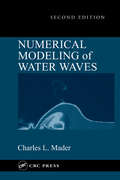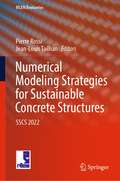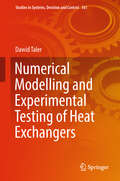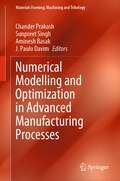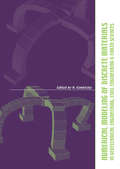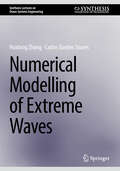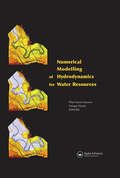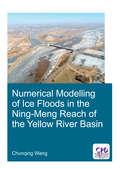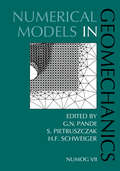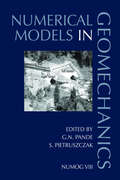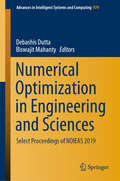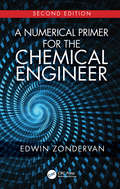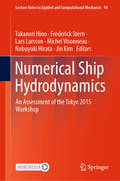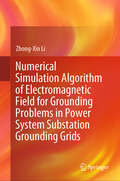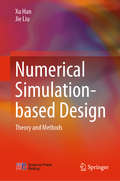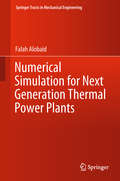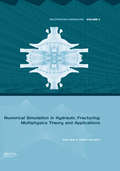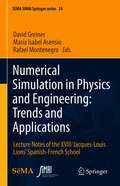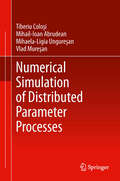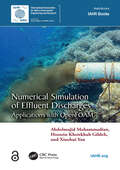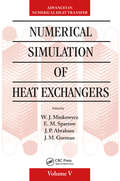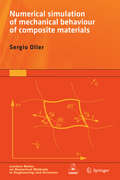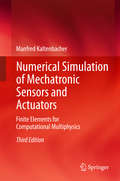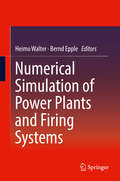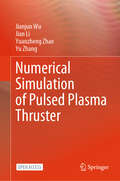- Table View
- List View
Numerical Modeling of Water Waves
by Charles L. MaderNumerical Modeling of Water Waves, Second Edition covers all aspects of this subject, from the basic fluid dynamics and the simplest models to the latest and most complex, including the first-ever description of techniques for modeling wave generation by explosions, projectile impacts, asteroids, and impact landslides. The book comes packaged with
Numerical Modeling Strategies for Sustainable Concrete Structures: SSCS 2022 (RILEM Bookseries #38)
by Pierre Rossi Jean-Louis TailhanThis volume highlights the latest advances, innovations, and applications in the field of sustainable concrete structures, as presented by scientists and engineers at the RILEM International Conference on Numerical Modeling Strategies for Sustainable Concrete Structures (SSCS), held in Marseille, France, on July 4-6, 2022. It demonstrates that numerical methods (finite elements, finite volumes, finite differences) are a relevant response to the challenge to optimize the utilization of cement in concrete constructions while checking that these constructions have a lifespan compatible with the stakes of sustainable development. They are indeed accurate tools for an optimized design of concrete constructions, and allow us to consider all types of complexities: for example, those linked to rheological, physicochemical and mechanical properties of concrete, those linked to the geometry of the structures or even to the environmental boundary conditions. This optimization must also respect constraints of time, money, security, energy, CO2 emissions, and, more generally, life cycle more reliably than the codes and analytical approaches currently used. Numerical methods are, undoubtedly, the best calculation tools at the service of concrete eco-construction. The contributions present traditional and new ideas that will open novel research directions and foster multidisciplinary collaboration between different specialists.
Numerical Modelling and Experimental Testing of Heat Exchangers (Studies in Systems, Decision and Control #161)
by Dawid TalerThis book presents new methods of numerical modelling of tube heat exchangers, which can be used to perform design and operation calculations of exchangers characterized by a complex flow system. It also proposes new heat transfer correlations for laminar, transition and turbulent flows. A large part of the book is devoted to experimental testing of heat exchangers, and methods for assessing the indirect measurement uncertainty are presented. Further, it describes a new method for parallel determination of the Nusselt number correlations on both sides of the tube walls based on the nonlinear least squares method and presents the application of computational fluid dynamic (CFD) modeling to determine the air-side Nusselt number correlations. Lastly, it develops a control system based on the mathematical model of the car radiator and compares this with the digital proportional-integral-derivative (PID) controller. The book is intended for students, academics and researchers, as well as for designers and manufacturers of heat exchangers.
Numerical Modelling and Optimization in Advanced Manufacturing Processes (Materials Forming, Machining and Tribology)
by Chander Prakash Sunpreet Singh Aminesh Basak J. Paulo DavimThis book presents different numerical modeling and nature-inspired optimization methods in advanced manufacturing processes for understanding the process characteristics. Particular emphasis is devoted to applications in non-conventional machining, nano-finishing, precision casting, porous biofabrication, three-dimensional printing, and micro-/nanoscale modeling. The book includes practical implications of empirical, analytical, and numerical models for predicting the vital output responses. Especial attention is given to finite element methods (FEMs) for understanding the design of novel highly complex engineering products, their performances, and behaviors under simulated processing conditions.
Numerical Modelling of Discrete Materials in Geotechnical Engineering, Civil Engineering and Earth Sciences: Proceedings of the First International UDEC/3DEC Symposium, Bochum, Germany, 29 September - 1 October 2004
by Heinz KonietzkyIn this fully up-to-date volume, important new developments and applications of discrete element modelling are highlighted and brought together for presentation at the First International UDEC/3DEC Symposium.Papers covered the following key areas:* behaviour of masonry structures (walls, bridges, towers, columns)* stability and deformation of tunne
Numerical Modelling of Extreme Waves (Synthesis Lectures on Ocean Systems Engineering)
by Huidong Zhang Carlos Guedes SoaresThis book describes some approaches for developing the numerical models to efficiently predict the formation of extreme waves which can pose a threat to the safety of marine structures. The numerical algorithms for solving different governing equations and the theoretical probability models for extreme wave predictions are explained in detail. These models can help engineers in the design of marine structures that can withstand extreme waves. With more frequent extreme weather due to climate change, extreme waves have become more common. Extreme waves are an interesting phenomenon, but because of their enormous destructive power, understanding their formation mechanism, properties, and impact, is necessary for the design and safe operation of ships and offshore structures.
Numerical Modelling of Hydrodynamics for Water Resources: Proceedings of the Conference on Numerical Modelling of Hydrodynamic Systems (Zaragoza, Spain, 18-21 June 2007)
by Pilar García-Navarro Enrique PlayánThe presentations collected in this volume have a problem-oriented perspective, and focus on canal and river flow, riparian areas and aquifers. 'Numerical Modelling of Hydrodynamics for Water Resources' is highly relevant to those working in hydrology, civil engineering, and environmental and agricultural sectors.
Numerical Modelling of Ice Floods in the Ning-Meng Reach of the Yellow River Basin (IHE Delft PhD Thesis Series)
by Chunqing WangThe Ning-Meng reach of the Yellow River basin is located in the Inner Mongolia region at the Northern part of the Yellow River. Due to the special geographical conditions, the river flow direction is towards the North causing the Ning-Meng reach to freeze up every year in wintertime. Both during the freeze-up and break-up period, unfavourable conditions occur which may cause ice jamming and ice dam formation leading to dike breaching and overtopping of the embankment. Throughout history this has often led to considerable casualties and property loss. Enhanced economic development and human activities in the region have altered the characteristics of the ice regime in recent decades, leading to several ice disasters during freezing or breaking-up periods. The integrated water resources management plan developed by the Yellow River Conservancy Commission (YRCC) outlines the requirements for water regulation in the upper Yellow River during ice flood periods. YRCC is developing measures that not only safeguard against ice floods, but also assure the availability of adequate water resources. These provide the overall requirements for developing an ice regime forecasting system including lead-time prediction and required accuracy. In order to develop such a system, numerical modelling of ice floods is an essential component of current research at the YRCC, together with field observations and laboratory experiments. In order to properly model river ice processes it is necessary to adjust the hydrodynamic equations to account for thermodynamic effects. In this research, hydrological and meteorological data from 1950 to 2010 were used to analyse the characteristics of ice regimes in the past. Also, additional field observations were carried out for ice flood model calibration and validation. By combining meteorological forecasting models with statistical models, a medium to short range air temperature forecasting model for the Ning-Meng reach was established. These results were used to improve ice formation modelling and prolong lead-time prediction. The numerical ice flood model developed in this thesis for the Ning-Meng reach allows better forecasting of the ice regime and improved decision support for upstream reservoir regulation and taking appropriate measures for disaster risk reduction.
Numerical Models in Geomechanics: Proceedings Of The Tenth International Symposium On Numerical Models In Geomechanics (numog X), Rhodes, Greece, 25-27 April 2007
by G. N. PandeIn this volume a number of developments on a variety of topics have been reported. These topics include: partially saturated soil; instabilities in soil behaviour; environmental geomechanics; parallel computing; and applications to tunnels, embankments, slopes, foundations and anchors.
Numerical Models in Geomechanics: Proceedings of the 8th International Symposium NUMOG VIII, Rome, Italy, 10-12 April 2002
by G. N. Pande S. PietruszczakThe papers in this volume reflect the current research and advances made in the application of numerical methods in geotechnical engineering. Topics include: instabilities in soil behaviour; environmental geomechanics; and hydro-mechanical coupling in problems of engineering.
Numerical Optimization in Engineering and Sciences: Select Proceedings of NOIEAS 2019 (Advances in Intelligent Systems and Computing #979)
by Debashis Dutta Biswajit MahantyThis book presents select peer-reviewed papers presented at the International Conference on Numerical Optimization in Engineering and Sciences (NOIEAS) 2019. The book covers a wide variety of numerical optimization techniques across all major engineering disciplines like mechanical, manufacturing, civil, electrical, chemical, computer, and electronics engineering. The major focus is on innovative ideas, current methods and latest results involving advanced optimization techniques. The contents provide a good balance between numerical models and analytical results obtained for different engineering problems and challenges. This book will be useful for students, researchers, and professionals interested in engineering optimization techniques.
A Numerical Primer for the Chemical Engineer, Second Edition
by Edwin ZondervanDesigned as an introduction to numerical methods for students, this book combines mathematical correctness with numerical performance, and concentrates on numerical methods and problem solving. It applies actual numerical solution strategies to formulated process models to help identify and solve chemical engineering problems. Second edition comes with additional chapter on numerical integration and section on boundary value problems in the relevant chapter. Additional material on general modelling principles, mass/energy balances and separate section on DAE’s is also included. Case study section has been extended with additional examples.
Numerical Ship Hydrodynamics: An Assessment of the Tokyo 2015 Workshop (Lecture Notes in Applied and Computational Mechanics #94)
by Takanori Hino Frederick Stern Lars Larsson Michel Visonneau Nobuyuki Hirata Jin KimThis book explores computational fluid dynamics applied to ship hydrodynamics and provides guidelines for the future developments in the field based on the Tokyo 2015 Workshop. It presents ship hull test cases, experimental data and submitted computational methods, conditions, grids and results. Analysis is made of errors for global (resistance, sinkage, trim and self-propulsion) and local flow (wave elevations, mean velocities and turbulence) variables, including standard deviations for global variables. The effects of grid size and turbulence models are evaluated for both global and local flow variables. Detailed analysis is made of turbulence modeling capabilities for capturing local flow physics. Errors and standard deviations are also assessed for added resistance (captive test cases) and course keeping/speed loss (free running test cases) in head and oblique waves. All submissions are used to evaluate the error and uncertainty by means of a systematic verification and validation (V&V) study along with statistical investigations.
Numerical Simulation Algorithm of Electromagnetic Field for Grounding Problems in Power System Substation Grounding Grids
by Zhong-Xin LiThis book focuses on numerical methods for grounding problems in substation grounding systems, which are rooted in horizontal multilayered earth models. The book discusses both theories and engineering applications and provides case studies to verify the accuracy of the methods introduced. Up to ten horizontal multilayered soil models were considered. This book employs numerical algorithms for Galerkin&’s method, including Galerkin&’s method of moments, Galerkin&’s boundary element method, and hybrid algorithms based on a variety of basis functions that have emerged as a result of simplifying Galerkin&’s method of moments. These numerical methods include both frequency and time domain algorithms that can be used to numerically simulate transient and steady state grounding problems in substation grounding grids. The most outstanding feature of this book is the incorporation of the frequency- and time-domain quasi-static complex imaging method (QSCIM) for point current sources in layered conducting media and its closed-form Green&’s function, as well as analytical algorithms for calculating the spatial two-dimensional line integrals of mutual impedances and inductances into numerical algorithmic modeling of electromagnetic fields, which greatly improves computational speed and accuracy.
Numerical Simulation-based Design: Theory and Methods
by Xu Han Jie LiuThis book focuses on numerical simulation-based design theory and methods inmechanical engineering. The simulation-based design of mechanical equipmentinvolves considerable scientific challenges including extremely complex systems,extreme working conditions, multi-source uncertainties, multi-physics coupling, andlarge-scale computation. In order to overcome these technical difficulties, this booksystematically elaborates upon the advanced design methods, covering high-fidelitysimulation modeling, rapid structural analysis, multi-objective design optimization,uncertainty analysis and optimization, which can effectively improve the designaccuracy, efficiency, multi-functionality and reliability of complicated mechanicalstructures.This book is primarily intended for researchers, engineers and postgraduate studentsin mechanical engineering, especially in mechanical design, numerical simulation andengineering optimization.
Numerical Simulation for Next Generation Thermal Power Plants (Springer Tracts in Mechanical Engineering)
by Falah AlobaidThe book provides highly specialized researchers and practitioners with a major contribution to mathematical models’ developments for energy systems. First, dynamic process simulation models based on mixture flow and two-fluid models are developed for combined-cycle power plants, pulverised coal-fired power plants, concentrated solar power plant and municipal waste incineration. Operation data, obtained from different power stations, are used to investigate the capability of dynamic models to predict the behaviour of real processes and to analyse the influence of modeling assumptions on simulation results. Then, a computational fluid dynamics (CFD) simulation programme, so-called DEMEST, is developed. Here, the fluid-solid, particle-particle and particle-wall interactions are modeled by tracking all individual particles. To this purpose, the deterministic Euler-Lagrange/Discrete Element Method (DEM) is applied and further improved. An emphasis is given to the determination of inter-phase values, such as volumetric void fraction, momentum and heat transfers, using a new procedure known as the offset-method and to the particle-grid method allowing the refinement of the grid resolution independently from particle size. Model validation is described in detail. Moreover, thermochemical reaction models for solid fuel combustion are developed based on quasi-single-phase, two-fluid and Euler-Lagrange/MP-PIC models. Measurements obtained from actual power plants are used for validation and comparison of the developed numerical models.
Numerical Simulation in Hydraulic Fracturing: Multiphysics Theory and Applications (Multiphysics Modeling #1)
by Xinpu Shen William StandifirdThe expansion of unconventional petroleum resources in the recent decade and the rapid development of computational technology have provided the opportunity to develop and apply 3D numerical modeling technology to simulate the hydraulic fracturing of shale and tight sand formations. This book presents 3D numerical modeling technologies for hydraulic fracturing developed in recent years, and introduces solutions to various 3D geomechanical problems related to hydraulic fracturing. In the solution processes of the case studies included in the book, fully coupled multi-physics modeling has been adopted, along with innovative computational techniques, such as submodeling. In practice, hydraulic fracturing is an essential project component in shale gas/oil development and tight sand oil, and provides an essential measure in the process of drilling cuttings reinjection (CRI). It is also an essential measure for widened mud weight window (MWW) when drilling through naturally fractured formations; the process of hydraulic plugging is a typical application of hydraulic fracturing. 3D modeling and numerical analysis of hydraulic fracturing is essential for the successful development of tight oil/gas formations: it provides accurate solutions for optimized stage intervals in a multistage fracking job. It also provides optimized well-spacing for the design of zipper-frac wells.Numerical estimation of casing integrity under stimulation injection in the hydraulic fracturing process is one of major concerns in the successful development of unconventional resources. This topic is also investigated numerically in this book. Numerical solutions to several other typical geomechanics problems related to hydraulic fracturing, such as fluid migration caused by fault reactivation and seismic activities, are also presented. This book can be used as a reference textbook to petroleum, geotechnical and geothermal engineers, to senior undergraduate, graduate and postgraduate students, and to geologists, hydrogeologists, geophysicists and applied mathematicians working in this field. This book is also a synthetic compendium of both the fundamentals and some of the most advanced aspects of hydraulic fracturing technology.
Numerical Simulation in Physics and Engineering: Lecture Notes of the XVIII ‘Jacques-Louis Lions’ Spanish-French School (SEMA SIMAI Springer Series #24)
by David Greiner María Isabel Asensio Rafael MontenegroThis book results from the XVIII Spanish-French School 'Jacques Louis Lions' on Numerical Simulation in Physics and Engineering, that took place in Las Palmas de Gran Canaria from 25th to 29th June 2018. These conferences are held biennially since 1984 and sponsored by the Spanish Society of Applied Mathematics (SEMA). They also have the sponsorship of the Société de Mathématiques Appliquées et Industrielles (SMAI) of France since 2008. Each edition is organized around several main courses and talks delivered by renowned French/Spanish scientists. This volume is highly recommended to graduate students in Engineering or Science who want to focus on numerical simulation, either as a research topic or in the field of industrial applications. It can also benefit senior researchers and technicians working in industry who are interested in the use of state-of-the-art numerical techniques. Moreover, the book can be used as a textbook for master courses in Mathematics, Physics, or Engineering.
Numerical Simulation of Distributed Parameter Processes
by Mihail-Ioan Abrudean Vlad Muresan Tiberiu Colosi Mihaela-Ligia UnguresanThe present monograph defines, interprets and uses the matrix of partial derivatives of the state vector with applications for the study of some common categories of engineering. The book covers broad categories of processes that are formed by systems of partial derivative equations (PDEs), including systems of ordinary differential equations (ODEs). The work includes numerous applications specific to Systems Theory based on Mpdx, such as parallel, serial as well as feed-back connections for the processes defined by PDEs. For similar, more complex processes based on Mpdx with PDEs and ODEs as components, we have developed control schemes with PID effects for the propagation phenomena, in continuous media (spaces) or discontinuous ones (chemistry, power system, thermo-energetic) or in electro-mechanics (railway - traction) and so on. The monograph has a purely engineering focus and is intended for a target audience working in extremely diverse fields of application (propagation phenomena, diffusion, hydrodynamics, electromechanics) in which the use of PDEs and ODEs is justified.
Numerical Simulation of Effluent Discharges: Applications with OpenFOAM (IAHR Books)
by Abdolmajid Mohammadian Hossein Kheirkhah Gildeh Xiaohui YanNumerical Simulation of Effluent Discharges: Applications with OpenFOAM provides a resource for understanding the effluent discharge mechanisms and the approaches for modeling them. It bridges the gap between academia and industry with a focused approach in CFD modeling and providing practical examples and applications. With a detailed discussion on performing numerical modeling of effluent discharges in various ambient waters and with different discharge configurations, the book covers the application of OpenFOAM in effluent discharge modeling. Features: Discusses effluent discharges into various ambient waters with different discharge configurations. Focuses on numerical modeling of effluent discharges. Covers the fundamentals in predicting the mixing characteristics of effluents resulting from desalination plants. Reviews the past CFD studies on the effluent discharge modeling thoroughly. Provides guidance to researchers and engineers on the future steps in modeling of effluent discharges. Includes an introduction to OpenFOAM and its application in effluent discharge modeling. The book will benefit both academics and professional engineers practicing in the area of environmental fluid mechanics and working on the effluent discharge modeling.
Numerical Simulation of Heat Exchangers: Advances in Numerical Heat Transfer Volume V (Computational and Physical Processes in Mechanics and Thermal Sciences)
by W. J. Minkowycz; E. M. Sparrow; J. P. Abraham; J. M. GormanThis book deals with certain aspects of material science, particularly with the release of thermal energy associated with bond breaking. It clearly establishes the connection between heat transfer rates and product quality. The editors then sharply draw the thermal distinctions between the various categories of welding processes, and demonstrate how these distinctions are translated into simulation model uniqueness. The book discusses the incorporation of radiative heat transfer processes into the simulation model.
Numerical Simulation of Mechanical Behavior of Composite Materials
by Sergio OllerAn original mechanical formulation to treat nonlinear orthotropic behavior of composite materials is presented in this book. It also examines different formulations that allow us to evaluate the behavior of composite materials through the composition of its components, obtaining a new composite material. Also two multiple scale homogenization methods are given, one based on the analytical study of the cells (Ad-hoc homogenization) and other one, more general based on the finite element procedure applied on the macro scale (upper-scale) and in the micro scale (sub-scale). A very general formulation to simulate the mechanical behavior for traditional composite structures (plywood, reinforced concrete, masonry, etc. ), as well as the new composite materials reinforced with long and short fibers, nanotubes, etc. , are also shown in this work. Typical phenomena occurring in composite materials are also described in this work, including fiber-matrix debonding, local buckling of fibers and its coupling with the overall buckling of the structure. Finally, several numerical examples that evaluates the qualities and capabilities of the general model formulated are offered in this book. This book is intended for graduate engineering students who want to expand their knowledge of composite structures behavior.
Numerical Simulation of Mechatronic Sensors and Actuators
by Manfred KaltenbacherLike the previous editions also the third edition of this book combines the detailed physical modeling of mechatronic systems and their precise numerical simulation using the Finite Element (FE) method. Thereby, the basic chapter concerning the Finite Element (FE) method is enhanced, provides now also a description of higher order finite elements (both for nodal and edge finite elements) and a detailed discussion of non-conforming mesh techniques. The author enhances and improves many discussions on principles and methods. In particular, more emphasis is put on the description of single fields by adding the flow field. Corresponding to these field, the book is augmented with the new chapter about coupled flow-structural mechanical systems. Thereby, the discussion of computational aeroacoustics is extended towards perturbation approaches, which allows a decomposition of flow and acoustic quantities within the flow region. Last but not least, applications are updated and restructured so that the book meets modern demands.
Numerical Simulation of Power Plants and Firing Systems
by Heimo Walter Bernd EppleThe book comprises the fundamentals of the numerical simulation of fluid flows as well as the modelling of a power plant and plant components. The fundamental equations for heat and mass transfer will be prepared for the application in the numerical simulation. Selected numerical methods will be discussed in detail. The book will deal with the gas as well as with the water/steam flow. Regulation and controller, simplified models and hybrid models as well as the validation of measurement data are also included in the book.
Numerical Simulation of Pulsed Plasma Thruster
by Jianjun Wu Jian Li Yuanzheng Zhao Yu ZhangThis is an open access book. It is valuable in gaining an understanding of the working mechanism of pulsed plasma thrusters. It facilitates the evaluation of the thruster's working characteristics and propulsive performance, thereby providing a crucial theoretical foundation and reference for the design, development, and engineering application of pulsed plasma thrusters. Additionally, this book significantly contributes to the advancement of space electric propulsion technology. Researchers and engineers in the aerospace propulsion field can greatly benefit from the insights presented within this book.
